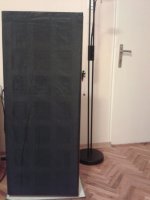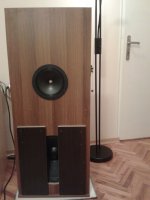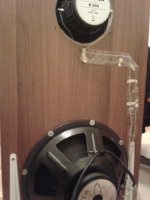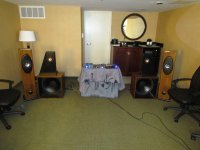Once you start looking at the efficiency and excursion trade-offs the 'naked dipole' folks have to make, it no longer makes sense, at least to me. Yes, you get perfect polars. But good sound is more than perfect polars. Music requires dynamics, which these designs will simply not do.
you think that this OB lacks dynamics? he he 
http://www.hifi-forum.de/index.php?action=browseT&forum_id=104&thread=22807
http://www.hifi-forum.de/index.php?action=browseT&forum_id=104&thread=22807
Let me point out that the failure of the the OB/H-baffle combination in my scenario was not the OB's. They performed pretty much as I had anticipated. The problem was my failure to understand the limitations of the H-frames. I had expected to run the H-frames up to the OB's. I now know that ~70Hz is as high as this particular configuration can go. In a word, the boxes I build will NEVER work with an OB.
I don't doubt that a big baffle OB would work with these drivers, but that is not my goal. Going with small baffle OB's of reasonable size (to me!) requires a bass speaker that can to up to the required 300Hz, or at least 200Hz it I increased the size of OB's by double -- not something i want to do. I think I mentioned above that I am looking at the Dayton RSS315HF in something like 3'^3 sealed. this would easily go high enough and would also go easily into the 20's in room.
But time is short before LSAF, so that will have to wait until summer.
Bob
I don't doubt that a big baffle OB would work with these drivers, but that is not my goal. Going with small baffle OB's of reasonable size (to me!) requires a bass speaker that can to up to the required 300Hz, or at least 200Hz it I increased the size of OB's by double -- not something i want to do. I think I mentioned above that I am looking at the Dayton RSS315HF in something like 3'^3 sealed. this would easily go high enough and would also go easily into the 20's in room.
But time is short before LSAF, so that will have to wait until summer.
Bob
you think that this OB lacks dynamics? he he
http://www.hifi-forum.de/index.php?action=browseT&forum_id=104&thread=22807
First, that is not nude. Second, I have very similar drivers (AN8 and Deltalite 2515II) and I've mated them on an OB. You need plenty of EQ below 100 Hz. The Kappalite does have more excursion, but that is exactly what I mean. As you go for better drivers (lower Qts, bigger magnets, better midbass), you need a bigger baffle to keep the EQ to a respectable level. Nothing wrong with building bigger baffles. But with nude, you are looking at serious power. I want to go in the other direction, higher efficiency, less excursion, less distortion, better Class A amps. IMO, this is more elegant.
Although, the choice of drivers in that design is top notch. Plenty of efficiency to throw away before it starts getting serious. Well done. Bet it sounds good.
with none of the boxless spacious sound of a full spectrum OB speaker.
Or any of the problams an OB introduces. One of the boxiest speakers i've ever heard was an OB.
Every loudspeaker has its wn set of issues.
dave
The open baffle midrange design concept has never appealed to me even though there are enough open baffle (dipole) mid/ box bass (omni) designs out there, I assume for practical (size) reasons.
My original inspiration for open baffle design was the Celestion 6000 system. Celestion System 6000 loudspeaker system | Stereophile.com
At the time (25 years ago) mini-monitors (Proac Tablette and Elipsion 1400) were my cuppa tea since they removed the leaden boxy bass I disliked.
The Celestion system offered the best of both worlds but required bespoke electronic x-overs which did not appeal to my DIY sensiblities. I did build a 3-way open baffle system 15 years ago but could never get a handle on the open midrange. The bass was remarkably "detailed" - free from colouration.
I've built a number of speakers since, learning much on these type of internet forums. I am now building an open baffle bass/mid-bass reflex system returning to my original inspiration: the Celestion system. I've spent the winter building the cabinents so my plan is to work on the x-over over the spring and summer using a fullrange driver in the bass reflex portion to keep things simple.
I hope this post gives others some alternative design ideas for open baffle bass.
Ron
Listening to: The Long Ryders - Native Sons
My original inspiration for open baffle design was the Celestion 6000 system. Celestion System 6000 loudspeaker system | Stereophile.com
At the time (25 years ago) mini-monitors (Proac Tablette and Elipsion 1400) were my cuppa tea since they removed the leaden boxy bass I disliked.
The Celestion system offered the best of both worlds but required bespoke electronic x-overs which did not appeal to my DIY sensiblities. I did build a 3-way open baffle system 15 years ago but could never get a handle on the open midrange. The bass was remarkably "detailed" - free from colouration.
I've built a number of speakers since, learning much on these type of internet forums. I am now building an open baffle bass/mid-bass reflex system returning to my original inspiration: the Celestion system. I've spent the winter building the cabinents so my plan is to work on the x-over over the spring and summer using a fullrange driver in the bass reflex portion to keep things simple.
I hope this post gives others some alternative design ideas for open baffle bass.
Ron
Listening to: The Long Ryders - Native Sons
Or any of the problams an OB introduces. One of the boxiest speakers i've ever heard was an OB.
Every loudspeaker has its own set of issues.
dave
let me second guess the "boxiest" comment - very coloured /closed in midrange was what I heard - due I think to a "perfect storm" - combination of XO frequency & slopes & component quality, and quality of compression driver on specific co-ax driver (actually not too much unlike what I found with the Hammer Dynamics Super12 - so I don't think it's a simple issue of "enclosure" or lack thereof)
my biggest issue with any OB the sound with which I could fall in love (there have been a couple), was finding a space to live with them after being kicked out - "not in MY home you don't" - and y'all can save your time on the relationship advice - it's all a compromise, and after 40yrs in the same one, I know how good I've got it.
Yes indeed. They require the right room. That's the funny thing, is that big speakers that can control directivity better, with all the advantages that brings, are most needed in small rooms. With dipoles, you have to assume several feet of clearance as part of the speaker, it's not optional. The alternative is horns- more speaker but can be butted right up against the back wall. Either way it's a lot of real estate to use speakers that minimize the room.
God bless my wife, I get to do pretty much whatever I want, which means HUGE.
God bless my wife, I get to do pretty much whatever I want, which means HUGE.
Hi,
Looks like the open baffle speakers must be either loved or hated! I did both
When I built my OB's, they were essentially a copy of Visaton No box design:
The VISATON NoBox BB Loudspeaker Kit Review By Dick Olsher
But I didn't like them., With its crossover points and big side wings, bass was muddy and even honky, there was some resonance I couldn't stand...
5 years later and a lot of experimentation, I ended up with the ones as you see on pics. Removed the wings, but added front "slot". Yes, they are ugly, but I don't care. It was "quick n'dirty" test that worked so I left it as it was. (The Slot idea came from Nelson Pass OB's-thanks!). Also, the crossover got a lot of rework. Now it's active, with the high pass set on 150 Hz 2nd order, and Low Pass (with boost) at 80 hz, 2nd order. Hint: Read Nelson Pass article:The Slot Loaded Open Baffle Project Article By Nelson Pass
What Bob has done, looks more like a "Fast" concept, with a fullranger and a bass support, bass being an H-frame OB- not bad...
Looks like the open baffle speakers must be either loved or hated! I did both
When I built my OB's, they were essentially a copy of Visaton No box design:
The VISATON NoBox BB Loudspeaker Kit Review By Dick Olsher
But I didn't like them., With its crossover points and big side wings, bass was muddy and even honky, there was some resonance I couldn't stand...
5 years later and a lot of experimentation, I ended up with the ones as you see on pics. Removed the wings, but added front "slot". Yes, they are ugly, but I don't care. It was "quick n'dirty" test that worked so I left it as it was. (The Slot idea came from Nelson Pass OB's-thanks!). Also, the crossover got a lot of rework. Now it's active, with the high pass set on 150 Hz 2nd order, and Low Pass (with boost) at 80 hz, 2nd order. Hint: Read Nelson Pass article:The Slot Loaded Open Baffle Project Article By Nelson Pass
What Bob has done, looks more like a "Fast" concept, with a fullranger and a bass support, bass being an H-frame OB- not bad...
Attachments
Vix, I wouldn't say "hated" in the sense of rejecting the sonic qualities they can have in the right room, as much as "won't work / fit in available space"
I was probably more impressed by the musicality of a Lowther / Tone Tubby OB system that Jon Ver Halen demo'ed at VSAC2008 than any of the dozens of other systems I heard (of among probably hundreds there) - but even if I could afford the cost of a cheap facsimile thereof, the required floorspace and "DAF" would hobble the project from the starting block.
I was probably more impressed by the musicality of a Lowther / Tone Tubby OB system that Jon Ver Halen demo'ed at VSAC2008 than any of the dozens of other systems I heard (of among probably hundreds there) - but even if I could afford the cost of a cheap facsimile thereof, the required floorspace and "DAF" would hobble the project from the starting block.
I agree with godzilla on baffle size.I'm an amatuer builder with unlimited access to plywood when I used my b200's on open baffle. I always thought wings or equalization messed up the sound and I had a preference for about a 48" X30" flat bafffle.Some of the drivers I went through fostex fe27e,hawthorne audio silver Iris,visaton b200,markaudio chr70 and alpair 10.Also had dcx2496 to crossover to seas tdfc tweeters and a pair of seas 10" woofers. I never liked any of the smaller drivers on open baffle I'm with linkitz on the 8" size it has more full liflike sound that I never could get out of anything smaller even considering I could use crossover to woofers or try to equalize it back in. I still like a single full range driver direct to Tamp best with no crosovers or subwoofers. I currently use alpair 10 in a bass reflex as computer speakers for gaming which go amazing low, but I miss my open baffle b200's one of the few speakers that gave me goosebumps and make my hair stand up.I pushed them very hard computer gaming with no low end protection and damaged one, and yes the real estae needed for them took up most of the room.I'm not a knowledgeable audio guy like Bob Brines . Godzilla ,chrisb or planet10 but I have followed these peoples post for years and learned from them.
Update on my attempt at a dipole system:
I finally solved the cross-over problem. I was overdriving the ADC stage of the miniDSP I am using to do the XO. I started a discussion about this on the PE forum, but I got tired of being treated as an absolute idiot. Those guys basically don’t know anything other than a 2-way monkey coffin.
Using a DSP box to do XO and EQ is fraught with pitfalls. I did both on the miniDSP, and with the bass boost required for an H-frame, wound up clipping the DAC side. I was in a hurry and didn’t have time to play with all of the combinations and permutations of Foobar2000 > DAC > miniDSP > bi-amp. My first order of business is to take the EQ off of the miniDSP and put it in the music player. That will give me better control of levels down the chain. Anyway….
Here is the setup:
The room at an Embassy Suite in Dallas for LSAF 2012 is ~15’x20’x8’.
The electronics left to right are Topping TP-60 (high amp), M-Audio FastTrack Pro (DAC), Smith&Larson Woofer Tester Pro (of display for advertising), Dayton DTA-100 (low amp). The front end is Foobar2000 on a laptop USB to the DAC.
The OB’s are Alpair 7.2’s on a 15”to 7.5” wide 20” high baffle. The H-frames are Goldwood GW-1858’s.
The music played was preferably CD’s brought in by visitors or whatever was requested from my library. Barring any requests, I used
Alison Krauss & Robert Plant: “Your Long Journey” (Raising Sand)
Fleetwood Mac: “Never Going Back Again” (Rumours)
Steely Dan: “Josie” (Aja)
Pink Floyd: “Time” (Echoes - The Best Of Pink Floyd (disc 2))
Led Zeppelin: “Good Times Bad Times” (Mothership)
Mussorgsky: “Pictures At An Exhibition” (An organ transcription – details upon request)
My impression, flavored by visitor comments:
Wow! I have never had speakers with is level of dynamics. Of course, dynamics decrease as you go down the program list, dynamics become increasingly compressed so that by the Led Zeppelin, it was just loud. The Mussorgsky, however, went from “turn it up a little, please” to downright deafening. The overall sound was airy and reverberant. That’s the OB sound. When compared to the other pair of speakers (Alpair 10.2’s in my M10-A10 MLTL), the OB’s sound more euphonic with reduced imaging. This is good on dry recordings, but overkill on recordings that are quite reverberant to start with. I am going to have to play with these OB’s and my little TL’s using the A7.3. It’s going to get down to what sounds best on the majority of my library. .
The audience was impressed with everything up to the Pink Floyd. The opinion was that my system played it OK, but not great. My guess is that I did not emphasize the 80-100Hz band and the speakers lacked slam. But, then, I am no expert on rock. The singular complaint was that there was a small hole at the cross-over point. I knew it was there because the particular software I had loaded on the miniDSP did not allow changing XO order. I will discuss this on the miniDSP forum soon
The H-frames performed beyond my wildest dreams. I expected them to die by 30Hz. No! They go way into the 20’s. The organ growled, shook the pictures on the walls, moved the OB’s sitting on top of them. This with a mere 30w/ch. BTW, they were 36” from the front wall, 30” from the sides and under a 7’ overhang.
I was pleased with the performance of this system. Some playing needs to be done. I will probably keep the H-frames. That goes on top is up in the air.
Bob
I finally solved the cross-over problem. I was overdriving the ADC stage of the miniDSP I am using to do the XO. I started a discussion about this on the PE forum, but I got tired of being treated as an absolute idiot. Those guys basically don’t know anything other than a 2-way monkey coffin.
Using a DSP box to do XO and EQ is fraught with pitfalls. I did both on the miniDSP, and with the bass boost required for an H-frame, wound up clipping the DAC side. I was in a hurry and didn’t have time to play with all of the combinations and permutations of Foobar2000 > DAC > miniDSP > bi-amp. My first order of business is to take the EQ off of the miniDSP and put it in the music player. That will give me better control of levels down the chain. Anyway….
Here is the setup:
The room at an Embassy Suite in Dallas for LSAF 2012 is ~15’x20’x8’.
The electronics left to right are Topping TP-60 (high amp), M-Audio FastTrack Pro (DAC), Smith&Larson Woofer Tester Pro (of display for advertising), Dayton DTA-100 (low amp). The front end is Foobar2000 on a laptop USB to the DAC.
The OB’s are Alpair 7.2’s on a 15”to 7.5” wide 20” high baffle. The H-frames are Goldwood GW-1858’s.
The music played was preferably CD’s brought in by visitors or whatever was requested from my library. Barring any requests, I used
Alison Krauss & Robert Plant: “Your Long Journey” (Raising Sand)
Fleetwood Mac: “Never Going Back Again” (Rumours)
Steely Dan: “Josie” (Aja)
Pink Floyd: “Time” (Echoes - The Best Of Pink Floyd (disc 2))
Led Zeppelin: “Good Times Bad Times” (Mothership)
Mussorgsky: “Pictures At An Exhibition” (An organ transcription – details upon request)
My impression, flavored by visitor comments:
Wow! I have never had speakers with is level of dynamics. Of course, dynamics decrease as you go down the program list, dynamics become increasingly compressed so that by the Led Zeppelin, it was just loud. The Mussorgsky, however, went from “turn it up a little, please” to downright deafening. The overall sound was airy and reverberant. That’s the OB sound. When compared to the other pair of speakers (Alpair 10.2’s in my M10-A10 MLTL), the OB’s sound more euphonic with reduced imaging. This is good on dry recordings, but overkill on recordings that are quite reverberant to start with. I am going to have to play with these OB’s and my little TL’s using the A7.3. It’s going to get down to what sounds best on the majority of my library. .
The audience was impressed with everything up to the Pink Floyd. The opinion was that my system played it OK, but not great. My guess is that I did not emphasize the 80-100Hz band and the speakers lacked slam. But, then, I am no expert on rock. The singular complaint was that there was a small hole at the cross-over point. I knew it was there because the particular software I had loaded on the miniDSP did not allow changing XO order. I will discuss this on the miniDSP forum soon
The H-frames performed beyond my wildest dreams. I expected them to die by 30Hz. No! They go way into the 20’s. The organ growled, shook the pictures on the walls, moved the OB’s sitting on top of them. This with a mere 30w/ch. BTW, they were 36” from the front wall, 30” from the sides and under a 7’ overhang.
I was pleased with the performance of this system. Some playing needs to be done. I will probably keep the H-frames. That goes on top is up in the air.
Bob
Attachments
Bob,
With MiniDSP, or pretty much any type of EQ, it is always better to cut than to boost. For example, rather than boosting the bass, lower the top. Either way, you are trading efficiency. If you do a passive XO, you will insert a resistor in series with the tweeter to pad it down to match the bass.
Like you noted, boosting may cause problems with the DSP units, which are not really designed to be a preamp with gain.
With MiniDSP, or pretty much any type of EQ, it is always better to cut than to boost. For example, rather than boosting the bass, lower the top. Either way, you are trading efficiency. If you do a passive XO, you will insert a resistor in series with the tweeter to pad it down to match the bass.
Like you noted, boosting may cause problems with the DSP units, which are not really designed to be a preamp with gain.
Bob,
With MiniDSP, or pretty much any type of EQ, it is always better to cut than to boost. For example, rather than boosting the bass, lower the top. Either way, you are trading efficiency. If you do a passive XO, you will insert a resistor in series with the tweeter to pad it down to match the bass.
Like you noted, boosting may cause problems with the DSP units, which are not really designed to be a preamp with gain.
EQ, particularly the amount necessary for an OB bass is going to cause problems somewhere. In the digital domain, boosting can bring noise up out of the floor. Cutting can push data into the floor. Boosting can cause clipping at the DAC. I was at this level and avoided clipping by backing off the input. I did it this way because I was in a hurry and this was the easy solution.
A better bet is to do the boost in the player. Clipping is easy to avoid here if enough attention is paid to the process. Once the level problems have been handled in the player, and the output level does not clip the ADC, no problems will occur in the miniDSP.
Boost and cut is a double edged sword. If you apply too much bass boost, you will have to cut the volume to avoid clipping. If instead you cut the treble, you reduce the volume. Same end result. If you split the difference, you split the difference. Same end result. Equalization means lower total volume.
Bob
I know nothing except what my ears tell me.
I'm glad you made the OBs wider... I'd go even wider.
The H-frames will be tough to replace sonically. I listen for enjoyment much more since building a pair.
I wanted the XO no higher than 300Hz and the baffle as small as possible. I did the trapezoid for some visual appeal. I don't want to go the 4x8 plywood sheet way to get decent bass. The H-frames performed wonderfully, given some room to breathe. I wa quite amazed at how well the metal A7's integrated with the paper Goldwoods right in the middle of voice fundamentals.
Bob
Are you still using the xover points and slopes described in post #15?
The OB rolls off at 300Hz, the H-frames in at 250Hz. This is not optimal, since the slopes don't match. Those with trained ears did hear a notch at the cross-over.
Bob
- Status
- This old topic is closed. If you want to reopen this topic, contact a moderator using the "Report Post" button.
- Home
- Loudspeakers
- Full Range
- My New Dipoles



